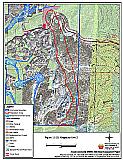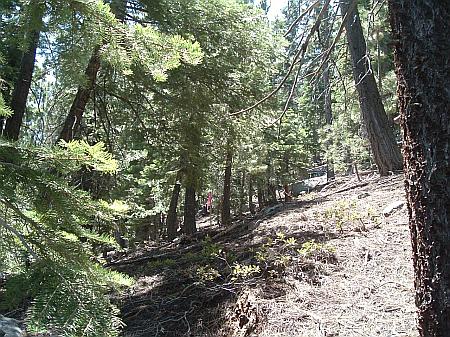Risk/Hazard Identification and Mitigation Project Worksheet
Name of Community: Kingsbury
Date: July, 2004
Project Title: Kingsbury Unit 2 - Thinning and Brush Removal
Description of Risk/Hazard: Describe in detail the risk or hazard that poses a threat to the community.
Vegetative Fuel and Topography: The Kingsbury Unit 2 prescription area is characterized by dense to open forest stands on 60% slopes. The mixed conifer stand is dominated by Jeffery pine and white fir with some red fir. Most of the unit has a closed canopy, which has excluded brush in the understory. In some of the open areas the brush understory is composed of golden chinkapin, greenleaf manzanita, pine mat manzanita, snowbrush, and mountain mahogany. There are many standing dead trees and dead-and-down woody debris. The duff layer is up to three inches thick in some places.
Priority Ranking: What is the priority ranking of this risk/hazard in relation to all others identified?
This community is on extremely steep slopes and no fuel reduction projects have been conducted in the area. It is outside of the Tahoe Basin, but could potentially bring a fire into the basin from the east side. Because most fuels are below the community, this project ranks as #1 for the TDFPD.
Location: Describe or attach a map with sufficient detail to allow accurate ground location.
North of State Route 207 along the east side of the ridge. See Figure 11-10 for details.
Recommended Mitigation Measures and Scope of Work: Present prescription and work specifications in sufficient detail to facilitate procurement of bids and quotes. For hazardous fuel removal projects include estimated volumes (tons/acre) of fuel removed and disposal plan.
Remove or thin brush understory to lower fire intensity and reduce ladder fuels. Remove dead and down material. Spacing between remaining bushes should be 2-3 times height of brush. Remove brush and smaller trees from underneath residual trees.
Thin forest stand from below, removing smaller trees and leaving larger ones to achieve the desired stocking rate of 80 to 100 square feet of basal area per acre. Where dominant trees are left, prune limbs to 15 feet above the ground and maintain a minimum tree spacing of 10 to 20 feet between crowns. Remove trees heavily infected with dwarf mistletoe or other disease.
Hand pile and burn the slash and debris. Run a prescribed fire through the area 5 years after the initial treatment. Treat a strip 1000 feet wide downslope from the structures.
Evaluation of the Extent to Which Completion of This Project Will Reduce the Fire Threat:
Treatment will reduce the chance of fire crowning in the area and burning up the east slope into the developed areas along the ridge. Implementation of the prescription will reduce the competition among residual trees, increasing forest health and decreasing tree mortality. This will reduce the amount of accumulated dead and down material contributing to the fuel loadings on the forest floor.
If all of the recommendations in this report are implemented, there is still no guarantee that a devastating wildfire will not occur in the area. However, community awareness and individual attention to fuels management on private property and fuel reduction on state, federal, and county property will help to achieve the highest level of wildfire safety possible.
Identification of Protected Species or Other Critical Resources: Describe any measures that must be taken to protect critical wildlife habitat, historic
Environmental compliance measures must be implemented before project initiation. Stream Environment Zones are located in the project area and must be protected, employing appropriate TRPA mitigation measures.
Some threatened and endangered species exist in the Tahoe Basin. Appropriate avoidance and mitigation measures should be employed during project implementation.
Compliance with cultural resource protection may also be necessary. Check with TRPA and the NVSHPO to ensure cultural resources are protected.
Post-project Rehabilitation: Present scope of work in sufficient detail to facilitate procurement of bids and quotes.
Rehabilitate any fire control lines, landings or disturbed areas. Rehabilitation will be minimal if only handmethods are used. Where soil has been disturbed, TRPA rehabilitation measures and Best ManagementPractices would apply. This could include reseeding or mulching areas if necessary.
Estimated Timeline:
Desirable time of year to complete:
May - December
Estimated time required to complete project:
Hand cut, pile and burn over three seasons.
Estimated Cost: Present an estimate of the total cost of project completion and the basis for the estimate presented. If the project can be subdivided into phases or various components, present an estimated cost for each.
Cable yarding is recommended, however, no costs for cable yarding were available. The costs below are a minimum based on currently accepted methods in the Tahoe Basin.
| Hand cut, pile, and burn | $2,000 / acre X 134 acres | |
| Prescribed fire within 5 years | $1,200 / acre X 134 acres | |
| Total Cost | $ 428,800 |
Biomass to be removed is approximately 59 tons / acre.
Project Maintenance Requirements:
Run prescribed fire through the area five years after the initial treatment
Run a prescribed fire at 10 year intervals
Re-thin the area in 15 to 20 years after the treatment.
Other Considerations: Describe any other considerations that must be taken into account to successfully complete this project such as permits, clearances, approvals, etc.
- Permission from landowners
- State (NDF) Timber Harvest permit and stream zone variance
- Air Quality Permit from Nevada Division of Environmental Protection
- USFS Approval
Prescription area is outside of the Tahoe Basin
Figure 11-10Proposed Prescription Area Kingsbury Unit 2 |
 |

